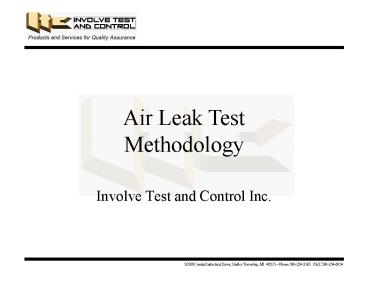Involve Test and Control Inc' PowerPoint PPT Presentation
1 / 9
Title: Involve Test and Control Inc'
1
Air Leak Test Methodology
- Involve Test and Control Inc.
2
NON-DESTRUCTIVE TESTING IS A NECESSITY
- Modern non-destructive leak testing is used by
manufacturers to - Ensure product integrity and reliability.
- Prevent failures and accidents.
- Ensure customer satisfaction and maintain
reputation. - Maintain a uniform level of quality.
- Aid in product design improvements.
- Control the manufacturing process.
- Lower manufacturing and warranty costs.
3
BUBBLE UNDERWATER LEAK TESTING
- Of all leak testing methods this is the easiest
to understand. - The part is pressurized while underwater. Are air
bubbles escaping from the part? If yes, the part
is leaking. - Unless specific techniques are used internal
leakage (one passage to another) can not be
detected visually. - It also identifies the approximate location of
any external part leakage. - It is very easy to miss seeing bubbles underwater
especially when part leakage is very slight. - Usually not practical for production leak
testing. It does not produce a quantitative leak
test result.
4
PRESSURE DECAY LEAK TESTING
- This method is also easy to understand and it
does indicate the magnitude of part leakage. - The part is pressurized to a given test air
pressure (FILL). - After reaching test air pressure, the air
pressure supply is shut-off (STABILIZATION). - The leak rate is calculated indirectly using a
formula based on the internal volume of the part
and a pressure drop over time (TEST). - To produce a measurable drop in pressure, more
time is required to sense small leakage in large
volume parts. - An acceptable method for measuring part leakage
if there is sufficient time (FILL STABILIZATION
TEST).
5
DIFFERENTIAL PRESSURE LEAK TESTING
- This method is similar to Pressure Decay leak
testing except the leak rate is calculated
indirectly after measuring the difference in air
pressure between a fixed and identical reference
test volume and air pressure in the
part-under-test. - If the part is not leaking, air pressure inside
the part equals air pressure inside the reference
test volume (no difference no leakage). - If the part leaks, the air pressure will be lower
inside the part when compared to the air pressure
inside the reference test volume (some difference
some leakage). - As with Pressure Decay leak testing, there must
be sufficient time to sense a pressure drop
between the part-under-test and the reference
test volume (sensitivity). - An acceptable method if there is sufficient time
(FILL STABILIZATION TEST).
6
MASS FLOW LEAK TESTING
- The part-under-test is pressurized and the leak
rate is measured directly. - When test air pressure is reached, air flow is
directed through a mass flow transducer. A mass
flow transducer is a device that generates a
voltage output in relationship to the amount of
air flowing through it. - If the part is leaking, air flows through the
mass flow transducer and into the part replacing
any air that is flowing out (leakage). - The leak rate is measured directly when air
flowing into the part equals the air flowing out
of the part. - An acceptable method for quickly measuring low to
high leak or flow rates.
7
LAMINAR FLOW LEAK TESTING
- Like Differential Pressure leak testing, the
difference in air pressure between the part-
under-test and the test air pressure is measured
to calculate the leak rate. However, laminar flow
leak testing directly measures the leak rate and
does not require a reference test volume. - Similar to Mass Flow leak testing air flows into
the part through a Laminar Flow Element (LFE) at
the same rate that it flows out of the part. - If the part is leaking, air pressure after the
LFE is lower than air pressure before the LFE. - Once the leak rate becomes fully stabilized, air
is flowing into the part at the same rate it is
flowing (leaking) out of the part. Once the air
pressure differential stops increasing actual
part leakage is produced.
8
ACCELERATED LAMINAR FLOW
Settle
Fill
Since the difference A at time point a is
proportional to difference B at time point b,
part leakage can be measured at time point a
accurately with repeatable results.
A
Flow curve for leak
Flow Through LFE
B
Flow curve for no-leak
Fully Stabilized
b
a
Time
- Air pressure differential across the LFE is
proportional to the air pressure difference
across the LFE before and after full
stabilization. Therefore, the leak rate can be
measured accurately before full stabilization.
Hence the term accelerated testing.
9
ACCELERATED MASS FLOW
Settle
Fill
Since the difference A at time point a is
proportional to difference B at time point b,
part leakage can be measured at time point a
accurately with repeatable results.
A
Flow Through Transducer
Flow curve for leak
B
Flow curve for no-leak
Fully Stabilized
b
a
Time
- Gas flowing into the part-under-test during
(SETTLE) is proportional to gas flowing out of
the part after full stabilization. Therefore, the
leak rate can be accurately measured before full
stabilization. Hence the term accelerated
testing. Accelerated testing is achieved when
(FILL) is sufficiently shortened to permit
forward flow into the part-under-test at the
start of (SETTLE).

